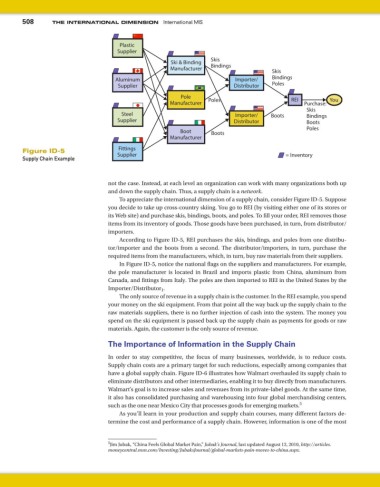Page 540 - Using MIS
P. 540
508 tHe InternatIonal DIMenSIon International MIS
Plastic
Supplier
Ski & Binding Skis
Manufacturer Bindings Skis
Aluminum Importer/ Bindings
Supplier Distributor Poles
Pole REI
Manufacturer Poles Purchase: You
Skis
Steel Importer/ Boots Bindings
Supplier Distributor Boots
Poles
Boot Boots
Manufacturer
Fittings
Figure ID-5 Supplier = Inventory
Supply Chain Example
not the case. Instead, at each level an organization can work with many organizations both up
and down the supply chain. Thus, a supply chain is a network.
To appreciate the international dimension of a supply chain, consider Figure ID-5. Suppose
you decide to take up cross-country skiing. You go to REI (by visiting either one of its stores or
its Web site) and purchase skis, bindings, boots, and poles. To fill your order, REI removes those
items from its inventory of goods. Those goods have been purchased, in turn, from distributor/
importers.
According to Figure ID-5, REI purchases the skis, bindings, and poles from one distribu-
tor/importer and the boots from a second. The distributor/importers, in turn, purchase the
required items from the manufacturers, which, in turn, buy raw materials from their suppliers.
In Figure ID-5, notice the national flags on the suppliers and manufacturers. For example,
the pole manufacturer is located in Brazil and imports plastic from China, aluminum from
Canada, and fittings from Italy. The poles are then imported to REI in the United States by the
Importer/Distributor 1 .
The only source of revenue in a supply chain is the customer. In the REI example, you spend
your money on the ski equipment. From that point all the way back up the supply chain to the
raw materials suppliers, there is no further injection of cash into the system. The money you
spend on the ski equipment is passed back up the supply chain as payments for goods or raw
materials. Again, the customer is the only source of revenue.
The Importance of Information in the Supply Chain
In order to stay competitive, the focus of many businesses, worldwide, is to reduce costs.
Supply chain costs are a primary target for such reductions, especially among companies that
have a global supply chain. Figure ID-6 illustrates how Walmart overhauled its supply chain to
eliminate distributors and other intermediaries, enabling it to buy directly from manufacturers.
Walmart’s goal is to increase sales and revenues from its private-label goods. At the same time,
it also has consolidated purchasing and warehousing into four global merchandising centers,
such as the one near Mexico City that processes goods for emerging markets. 5
As you’ll learn in your production and supply chain courses, many different factors de-
termine the cost and performance of a supply chain. However, information is one of the most
5 Jim Jubak, “China Feels Global Market Pain,” Jubak’s Journal, last updated August 12, 2010, http://articles.
moneycentral.msn.com/Investing/JubaksJournal/global-markets-pain-moves-to-china.aspx.

